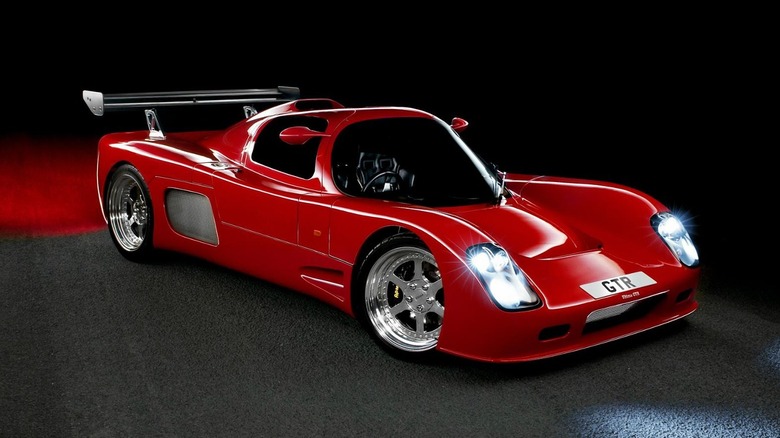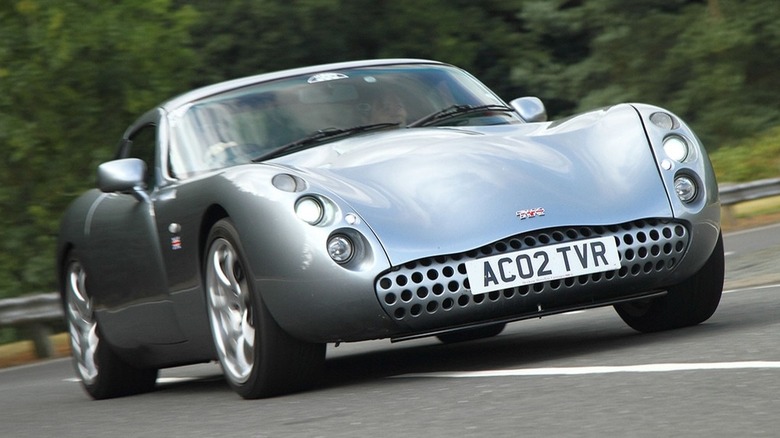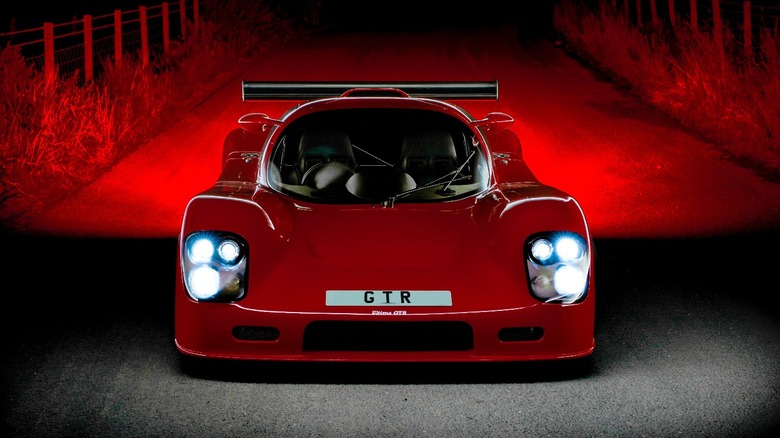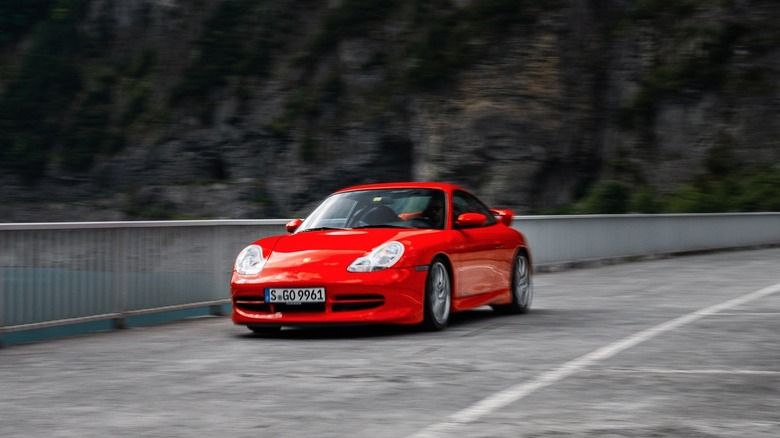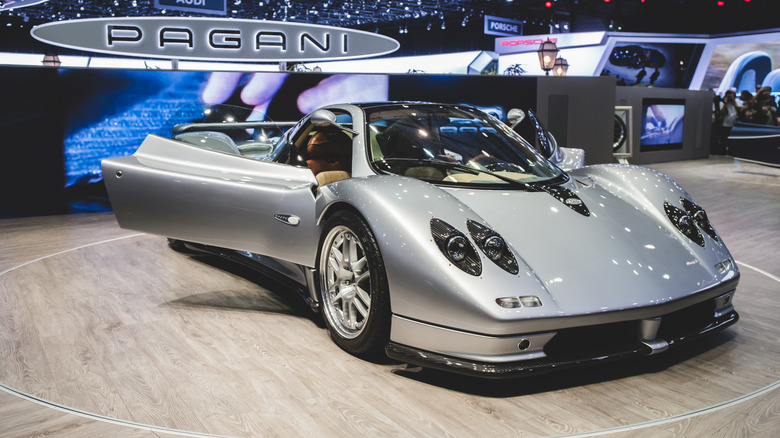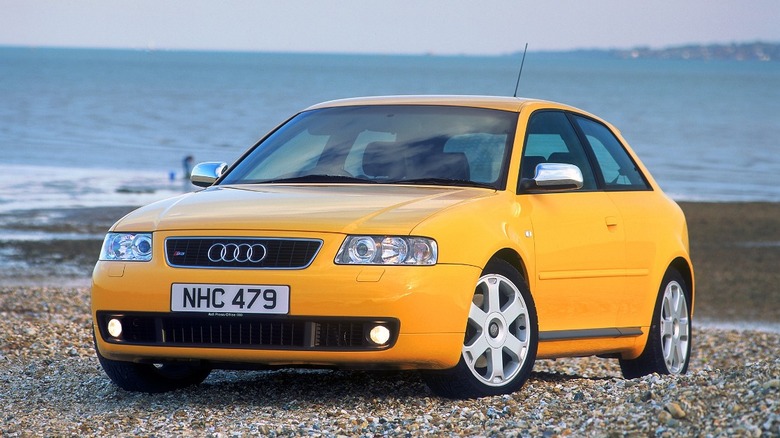5 Of The Coolest European Cars You Can Finally Import In 2024
The United States might be the home of Las Vegas and the Super Bowl but sometimes we miss out on the rest of the world's fun. That particularly applies to cars. The root of the problem stems from America's unique emissions and vehicle safety standards, which are determined using different metrics and requirements from those in Europe. In many cases, adapting a European-approved vehicle to meet U.S. regulations becomes such a massive headache that many manufacturers simply don't try, leaving American enthusiasts teary-eyed at the thought of what could have been.
While many beloved cars are banned in the U.S. because of that discrepancy, there is a gleam of hope in the Imported Vehicle Safety Compliance Act of 1988 — which started this whole mess to begin with — known as the 25-year import rule. The 1998 amendment to the act allows otherwise noncompliant foreign cars to be imported legally to the United States 25 years after the vehicle's production date. While there are other ways around the unfortunate law, they are typically only reserved for traveling military personnel or show and display cars, so the 25-year import rule is the best bet for Joe Schmo to get a European car that never reached U.S. soil at last.
1999 was 25 years ago as of 2024 and that means that there's a new roster of European classics eligible for U.S. adoption. Lucky for us, 1999 was a good year for European cars ranging from Group C-inspired track weapons to hopped-up hatchbacks.
TVR Tuscan Speed Six
Since the TVR name isn't commonly uttered stateside, less experienced enthusiasts might have never seen or heard of a single make from the rowdy British sports car marque. For those unfamiliar with the brand, Top Gear presenter Jeremy Clarkson summed up TVR best: "Owning a TVR in the past was like owning a bear, I mean it was great, until it pulled your head off, which it would." With that quote featured front and center on TVR's own website, it's clear that the company is proud of its sensationally sinister reputation.
Twenty-five years ago, the front-engined, rear-wheel drive Tuscan sports car entered production and carried on TVR's unhinged legacy. Its alien appearance alone is enough to tell you that the Tuscan sought to provide a very different experience to the comparably pedestrian German competition at the time including the BMW E36 M3 and Mercedes C43 AMG. Power was provided by a four-liter inline-six engine designed and manufactured by TVR to output 360 horsepower and 310 lb-ft of torque, dubbed the "Speed Six". TVR made sure that the only thing governing the Speed Six's potentially devastating wrath was the driver's right foot, as it didn't feature a single driver aid. There was no ABS and no traction control. That was one of the Tuscan's primary appeals, as well as the reason why many are now unidentifiable fiberglass masses in scrap yards.
Over the course of the Tuscan's seven-year build cycle, TVR refined the model to be a bit less of a handful, but the early versions were the purest form of the company's ethos. If you're looking to get your head pulled off, you can now own your very own Tuscan in the U.S. as of this year.
Ultima GTR
It's no wonder that the U.K.-built Ultima GTR didn't meet U.S. safety standards in 1999, mainly, but not exclusively, because it didn't come with any airbags. Yet somehow, shortly after the car's release, they began popping up in the garages of enthusiasts across the country. How was that possible? All of the car bound for America arrived via a box larger than even the most substantial Ikea order. The catch is that none of them had engines. Ultima found a loophole in the U.S. safety regulations allowing kit cars that didn't feature an engine to be sold stateside, with an engine to be installed later. While you couldn't just jump in and smoke rubber, the benefit was that the drivetrain could be completely customized to your liking.
The rest of the Ultima GTR was Group C-inspired madness. Being a kit car, the Ultima GTR featured nearly all-original parts including a bespoke in-house chassis. Most of the rest of the car around the chassis consisted of outsourced custom components of the highest fidelity. In other parts of the world, Ultima offered the GTR as a turnkey car, meaning that it came equipped from the factory with a wide array of V8 engine options to choose from. Over the years, Ultima GTR owners have experimented with engines ranging from 5.7-liter Ford V8s to 1,003 horsepower, fully built, twin-turbo LS2s. While a Lego-style build-a-car project might be right for some hardcore enthusiasts, others might not be so technically inclined. Until this year, sourcing an Ultima GTR was a luck-based ordeal hinging on domestic auction listings. Now that the turnkey cars can be imported, hopefully, there will be some more tearing up U.S. roads.
Porsche 911 GT3 (996.1)
Porsche is a prime example of a car manufacturer that can get away with taking a car, stripping it of all creature comforts, and charging more for it. The fifth generation of the Porsche 911, known by Porsche nerds as the 996, offered a model that fit that exact description. It was called the 911 GT3 and there was a very good reason why it lacked rear seats, sound deadening, air conditioning, and a sound system; it was a homologated race car.
Porsche has been building models that bridge the gap between street cars and racing thoroughbreds since the late 1960s. Cars like the Carrera RS 2.7, 964 Carrera RS, and 993 Carrera RS were all built as homologation specials –production models that Porsche was forced to build in order to compete in GT racing competitions. While the 996.1 GT3 dropped the Carrera nameplate, it was built for the exact same purpose as those earlier cars. The 911 GT3 was deeply infused with racing DNA that Porsche had been cultivating for decades prior to its release in 1999. The 996 was the first generation of road-going 911 to feature a water-cooled flat engine and the GT3 was no different. However, the 3.6-liter water-cooled flat-six used in the GT3 was a direct descendant of the one used in the 911 GT1 Le Mans car. The GT3 also featured highly adjustable suspension, a reinforced chassis, heftier brakes, and, last but not least, a massive rear wing. Now that 25 years have come and gone since the original GT3's release, now is your chance to own a pivotal piece of Porsche history.
Pagani Zonda C12
Pagani has been fighting with Lamborghini and Ferrari for the bedroom wall real estate of car-obsessed pre-teens for over two decades now. The company was spearheaded by a single man, Horacio Pagani, who was repeatedly ignored by even his most revolutionary contemporaries as his vision was too forward-thinking for them to grasp. As the head of Lamborghini's composite material department in 1985, Pagani fought to acquire an autoclave to allow Lamborghini to manufacture their own carbon fiber parts on a mass scale. Lamborghini turned him down, so he decided to get one for himself.
Years later, Pagani got to work on a production car of his own design. The car would eventually become the Pagani Zonda C12, a model that would help define a new era of composite supercars at the turn of the century. As to be expected, the Zonda C12 featured carbon fiber extensively and was sculpted to pay tribute to Mercedes' C9 and C11 Group C cars. Zonda's Mercedes DNA was more than skin deep; it utilized a rear-mounted Mercedes AMG V12 that made 389 horsepower and 420 lb-ft of torque. While the screams from the Zonda's V12 can only be described as feral, the C12's machined aluminum and Italian leather-adorned interior served as the engine's foil. While it might be easier to find a needle in a haystack than one of only five Zonda C12s built, they're now welcome in the U.S. if you can source one.
Audi S3
The BMW M, Mercedes AMG, and Audi S rivalry that has come to define the achievable dream car segment over the past 20 years was just reaching an opening crescendo in 1999. The BMW E36 M3, Mercedes C43 AMG, and Audi B5 S4 weren't the first models in their respective performance-focused lineups, but they were notably more refined than the cars that preceded them. While BMW and Mercedes were distracted by the performance sedan market, Audi Sport tried to pull a fast one by introducing a model of a very different kind — a three-door hatchback.
While the hot-hatch recipe had already been around for over 20 years by 1999, Audi was trying to breathe some life into it with the introduction of the S3. While BMW technically tried to do the same thing with its clown shoe-shaped Z3M Coupe in 1997, it fell short with only 2,858 ever built. Audi attempted to make it a more straightforward ordeal by using its mass-produced A3 three-door hatchback as a starting platform. From there the S3 got a number of sporty trimmings with a turbocharged 1.8-liter, 20-valve four-cylinder being the party piece. The S3 occupied a platform with the hate-it-or-love-it TT sports coupe that was released a year before, with the two sharing a fair number of parts.
The S3 launched with 207 horsepower and 199 lb-ft of torque, all-wheel drive, and three-door hatch real estate, making it an enticing Jack of all trades in a sedan-centric market. The S3 might not be a homologation special or a Group C prototype for the road, but it would make a sensible and fun import for family duties.
